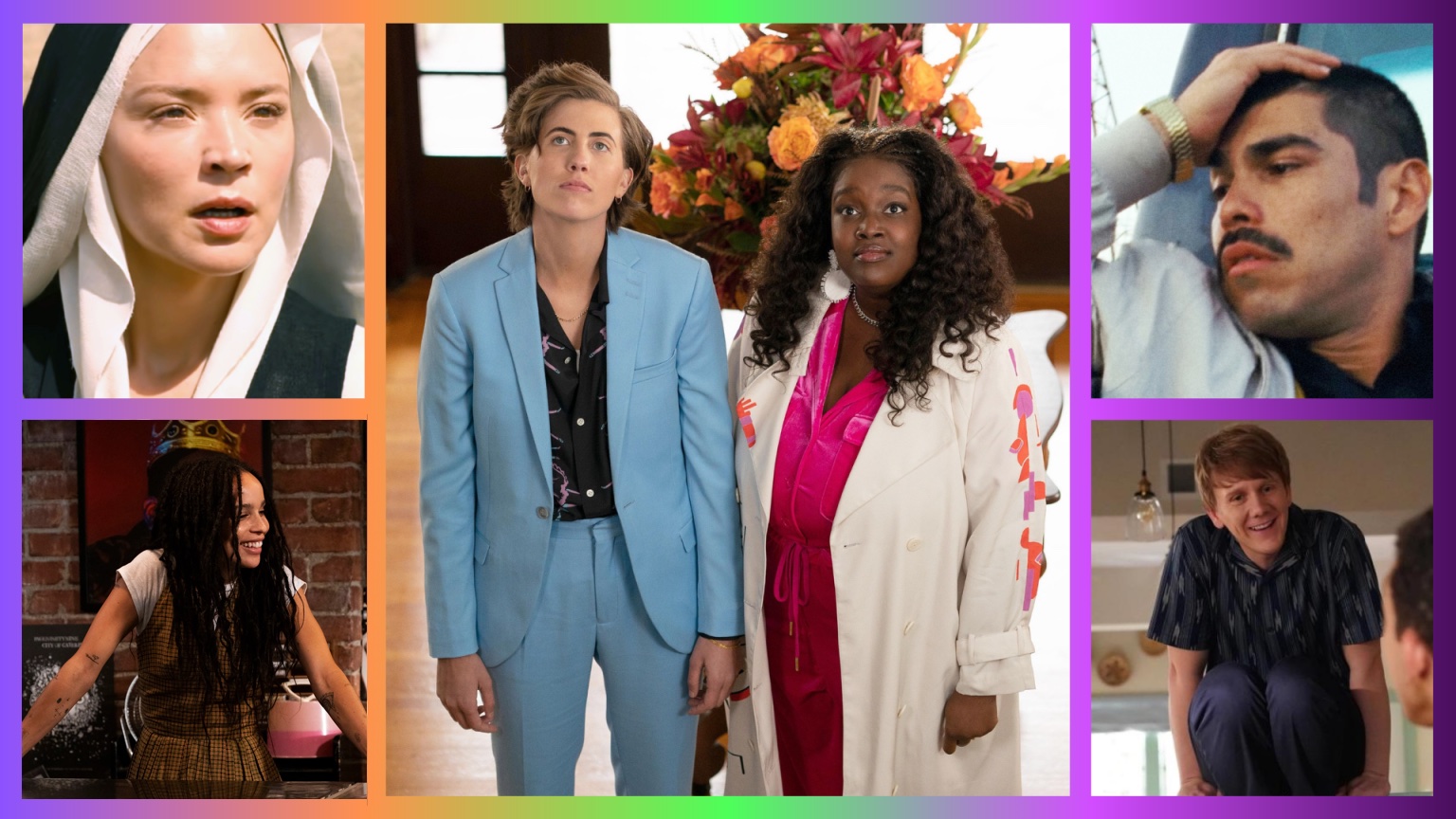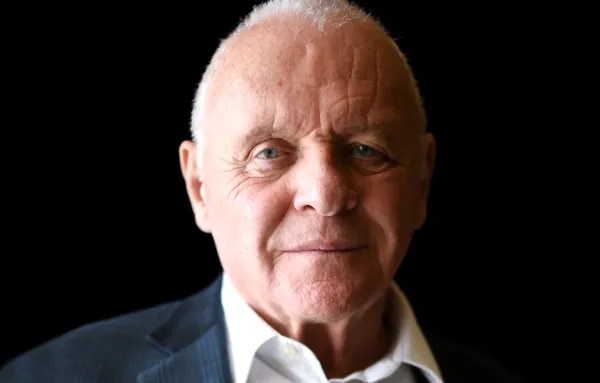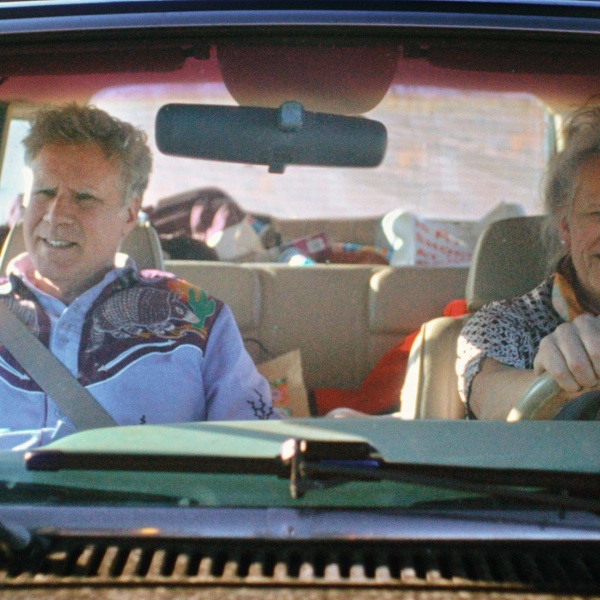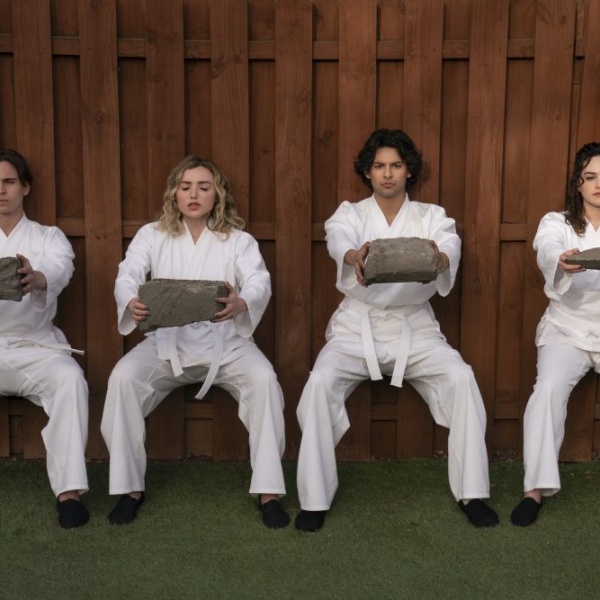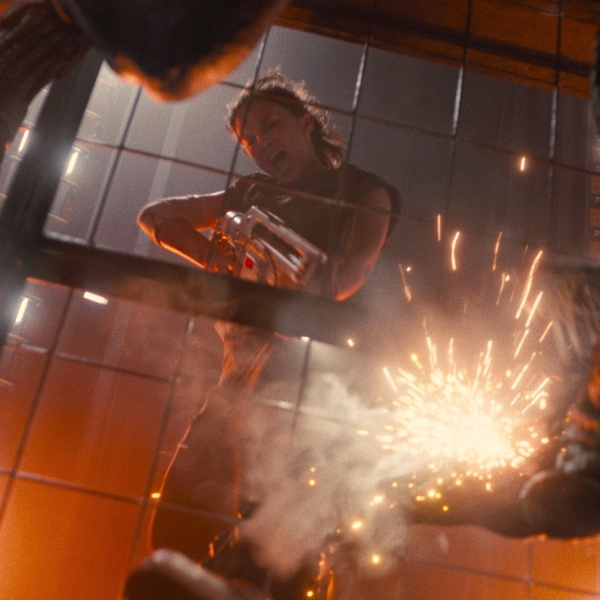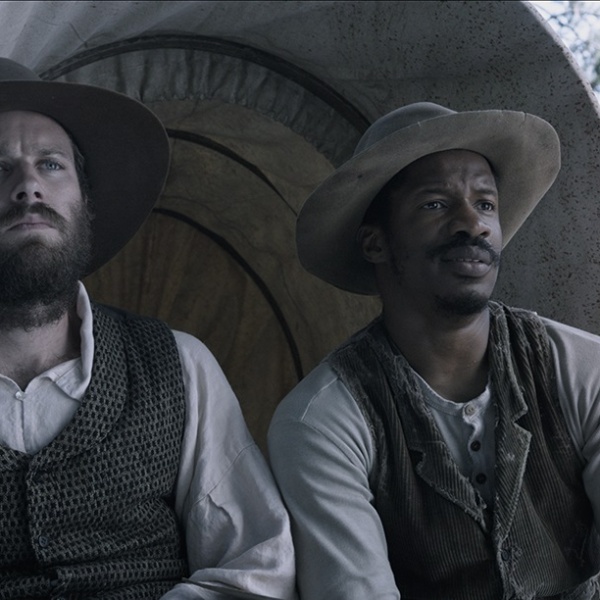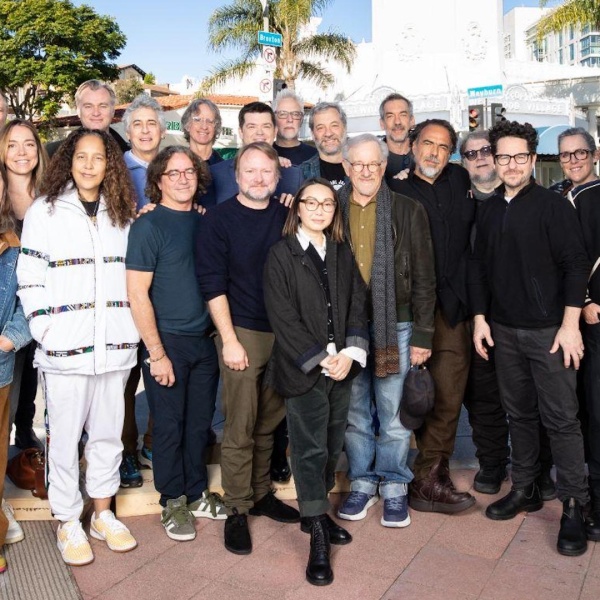
Hulu may have started out as the redheaded stepchild of the streamers back in Netflix’s heyday, but it has stuck around long enough to have firmly established itself as one of the old standbys. It follows, then, that Hulu would have a veritable fount of LGBTQ content ready to compete with the robust queer catalogues available to subscribers of Netflix, HBO, and other platforms.
A brief perusal of Hulu’s LGBTQ section doesn’t disappoint, but digging in deeper will give you the best chance at a genuinely memorable watch. Right now, the Disney-backed streamer is hosting popular queer television classics, like “The L Word,” “My So-Called Life,” and “RuPaul’s Drag Race,” alongside fresher fare, including “Everything’s Gonna Be Okay” and “Killing Eve.” Recent Hulu originals, such as “Love, Victor” and “Shrill,” deserve singling out, if only because you know they’re buzz-worthy and readily available on the service.
On the film side, old school classics are available, as are newer titles of various genres. “Fire Island” is a 2022 romantic comedy starring screenwriter Joel Kim Booster (sketch comedy fans will recognize him from “Saturday Night Live”) which reimagines “Pride and Prejudice” with hard-partying gay men from New York. Or you could try Paul Verhoeven’s “Benedetta”: a 2021 erotic psychological drama about two nuns in a 17th century Italian convent. (Yes, it’s another entry in the lesbian period romance subgenre; some of us aren’t tired of those yet!)
The best LGBTQ movies and TV on Hulu can be tough a list to curate, largely become of how different so many of these titles are. But whether it’s film or TV — something laugh-out-loud funny or a heartbreaking tearjerker — variety in LGBTQ entertainment is as important as it is impressive. (Hulu has even got “Midnight Kiss”: a sexy gay slasher set on New Year’s Eve in Palm Springs!)
We’ve combed through what Hulu has right now, and think at least 35 of its current titles are worth recommending. Films are listed first, followed by television series. Both categories are sorted alphabetically, and everything is streaming as of December 2023.
With editorial contributions by Jude Dry, Steve Greene, and Ryan Lattanzio.
-
“Benedetta” (2021)

Image Credit: ©IFC Films/Courtesy Everett Collection Dutch provocateur Paul Verhoeven strikes again, this time with a movie that lands somewhere on that vast Verhoeven spectrum between “Elle” and “Showgirls.” Based on a true story of a Renaissance-era nun and mystic, “Benedetta” inspired religious protestors to declare it the “blasphemous lesbian nun movie” — further cementing its must-see status. Both an erotic satire and a scathing critique of Catholicism and patriarchy, “Benedetta” is a political farce with a heaping dose of sex appeal. Discovered by the historian Judith C. Brown in the mid-1980s, Benedetta Carlini (Virginie Efira) was a 17th century mystic who had visions of Christ, claiming he wanted to marry her, and even received the stigmata. She was eventually stripped of her rank and imprisoned due to her sexual relationship with fellow novice Sister Bartolemea (Daphné Patakia).
Verhoeven plays up Benedetta’s flair for the dramatic to deliciously provocative ends, giving her religious embraces the same weight as her lustful longings. It’s never clear, to the more practical Bartolomea nor to the audience, just what Benedetta is playing at or how far her convictions go. Efira, who had a supporting role in “Elle,” is sly and seductive as the fanatic martyr, who dances playfully on the edge or narcissism and impassioned piety. Once she survives being burned at the stake, it’s clear even your craziest ex can’t hold a candle (or Virgin Mary dildo) to Benedetta. —JD
-
“Benediction” (2021)

Image Credit: ©Roadside Attractions/Courtesy Everett Collection A gorgeous and heartbreaking period drama, “Benediction” is a late-career masterpiece from director Terence Davies, who provides his signature elliptical style to the life story of war poet Siegfried Sassoon (played incredibly by Jack Lowden). A queer man who had several gay love affairs over the course of his life, Siegfried was sent to a psychiatric facility for his anti-war activism, got married, had a kid, and converted to Catholicism over the course of his complicated life. Using Siegfried’s poetry as bridges between the various stages of his life and the men he fell for, Davies guides the audience through the protagonist’s complicated story, showing how his experiences with war and his closeted existence shaped him for decades. And Lowden’s sensitive performance, equally bitchy and snide and haunted and sad, grounds the film, giving the audience an astonishing journey to witness. —WC
-
“Cowboys” (2020)

Image Credit: ©Samuel Goldwyn Films/Courtesy Everett Collection This tender buddy Western stars Steve Zahn as a modern-day Butch Cassidy who whisks his adorable Sundance kid away to the Montana mountains. Evoking the magic of the queer-coded Redford/Newman classic, “Cowboys” is an elegant revisionist Western that puts a complicated father figure and his adoring trans kid at the center. The film follows a young trans kid who is willingly abducted by his adoring but unreliable father, the only parent who supports him fully, as the two set off on the lam. As sweeping in grand landscapes as it is delicate in scope, writer/director Anna Kerrigan’s script keeps the focus tight, effectively crafting a satisfying adventure into a subtle excavation of masculinity — the good, the bad, and the ugly. —JD
-
“D.E.B.S” (2004)

Image Credit: ©Samuel Goldwyn Films/Courtesy Everett Collection At first glance from just the poster, “D.E.B.S” looks like an embarassing “Charlie Angels” clones from early 2000s that focuses more on titillation than giving the girls in the schoolgirl outfits real agency. But the movie comes from queer director Angela Robinson, and it’s sneakily one of the cutest sapphic romances of its decade. Set in a world where the SAT has a secret test that determines which women are suited to be spies, “D.E.B.S” follows four recruits of the titular military academy (it stands for Discipline, Energy, Beauty, Strength, if you’re wondering) who are tasked with defeating supercriminal Lucy Diamond (Jordana Brewster). But when one of the squad members Amy (Sara Foster) meets Lucy, unexpected sparks between the two polar opposites fly. The movie is essentially a campy action version of “But I’m a Cheerleader,” exploring how its blonde sweetheart lead manages to break away from the shackles of compulsory heterosexuality thanks to the presence of a brunette vixen. “D.E.B.S” bombed in theaters upon release, but queer people quickly championed it as the cult gay classic it is. —WC
-
“Fire Island” (2022)

Image Credit: Searchlight / 20th Century Studios Comedian Joel Kim Booster makes a splashy debut as both a formidable literary force and an appealing leading man in “Fire Island,” his first feature film as a screenwriter and hopefully the first of many. Though the vision was all Booster’s, the love that went into “Fire Island” emanates from every player, which includes “Saturday Night Live” darling Bowen Yang in a wonderfully emotive performance and “Spa Night” filmmaker Andrew Ahn proving he can do more than evocative indie dramas.
A true ensemble piece, the movie is filled with the joy and camaraderie of that cheesiest of queer epithets: chosen family. But under the Day-Glo sheen of the car-less beach town filled with glistening shirtless queers, it all feels genuinely dreamy. (Or maybe it’s the ketamine.) “Fire Island” marries the promise of the queer comedy boom with the artistic arrival of Asian American cinema. Gorgeously intersectional, subtly political, and a damn good time — it’s a guaranteed instant classic. —JD
-
“Flee” (2021)

Image Credit: Courtesy Everett Collection An inspired mix of genres allows this gripping animated documentary to transcend its wrenching story, offering intimate access to a story so personal and dangerous that its subject has never uttered a word of it before. The subject is Amin Nawabi, a Danish-Afghani man who arrived in Denmark 20 years ago as a child refugee. For the first time in his life, he tells his real story to his best friend, Danish filmmaker Jonas Poher Rasmussen, who listens openly from behind the camera. The film is seen mostly through rotoscope animation, a technique where animators trace over video footage, creating a simple but effective 2D appearance. The animation not only protects Amin’s identity, but easily transports the viewers through Amin’s harrowing journey from his childhood in Kabul to his family’s purgatory in Russia, and his eventual arrival in Copenhagen.
Rasmussen breaks up the story with Amin’s present-day struggles, showing how Amin’s past is affecting his relationship with his Danish fiancé Kasper. Kasper wants to buy a house and move to the country, while Amin chases professional opportunities abroad, hoping success will ease the guilt of the sacrifices his family made for him. It’s the kind of contemporary relationship issue that would be too subtle for a narrative film but makes perfect sense as a real-life conflict. In their highest form, documentaries can reveal humanity far more effectively than a written script ever could. “Flee” hits all those notes, and then some. —JD
-
“Happiest Season” (2020)

Image Credit: ©Hulu/Courtesy Everett Collection When “Happiest Season” was released in November 2020, what should have been a celebratory moment for the first major gay Christmas movie instead kicked up discourse over the actions of main character Harper (Mackenzie Davis). The daughter of a conservative politician, Harper invites her girlfriend Abby (Kristen Stewart) to her family home for Christmas without telling her she isn’t out and forces Abby to pretend to just be her friend for the weekend. Many branded Harper as unsympathetic and cruel based on the storyline, and it’s not hard to agree. But it’s the genuine pain and hurt between her and Abby that makes “Happiest Season” more than just a heartwarming Christmas rom-com and something interesting and worth watching, and Stewart and Davis are both terrific in their roles. Plus the film also features Aubrey Plaza in her most alluring mode possible as Harper’s ex, making for a love triangle that launched at least a thousand ship wars. —WC
-
“Her Smell” (2018)

Image Credit: Everett Collection / Everett Collection Elisabeth Moss delivers a tour de force performance (in a career full of them) in Alex Ross Perry’s monumental character study of a volatile rock star battling addiction, her own massive ego, and the tireless slog to remain relevant. Moss plays punk rocker Becky Something, frontwoman for a trio that imagines if Joan Jett and Sleater Kinney combined forces in the most toxic way imaginable. Gayle Rankin and Agyness Dean each buttress Moss’s erratic frontwoman as equally powerful collaborators and foils. Hailing from the modeling world, Dean is particularly enticing as the swaggering bass player Marielle Hell, the trio’s androgynous bassist who drowns out Becky’s noise with a blend of drugs, women, and masculine bravado. —JD
-
“Midnight Kiss” (2019)

Image Credit: Blumhouse For the second season of its popular horror anthology series “Into the Dark,” the executives at Blumhouse Productions were looking for something extra special. For 2019’s “Midnight Kiss,” a sexy gay slasher set amongst a group of L.A. gay friends on New Year’s Eve, Blumhouse tapped out gay talent — writer Erlingur Thoroddsen and director Carter Smith, who also hired all queer actors for the queer roles. The result is a campy whodunnit with clever barbs and genuine bite. Literally: The killer disguises themself with a leather fetish dog mask. Woof woof. —JD
-
“The Miseducation of Cameron Post” (2018)

Image Credit: Everett Collection / Everett Collection Based on Emily Danforth’s YA novel of the same name, “The Miseducation of Cameron Post” is a moving coming-of-age drama set at a gay conversion camp for Christian teens circa 1993. The film stars Chloë Grace Moretz as the eponymous teenager Cameron, who is shunted off to gay conversion camp after she’s caught in flagrante with her best friend. It also features a steely Jennifer Ehle, as well as compelling turns from Sasha Lane and Forrest Goodluck. For Desiree Akhavan, the filmmaker behind the disarmingly honest “Appropriate Behavior,” the film offered the chance to put a different spin on the stories she likes to tell. Akhavan’s wide compositions and innocuously searing long-takes provide plenty of room for her characters to feel things out, every moment of silence and square inch of negative space inviting them to question if they should take God’s Promise at its word. If the kids evoke John Hughes, their environment reeks of Todd Haynes. —DE
-
“Portrait of a Lady on Fire” (2019)

Image Credit: NEON Celine Sciamma’s luscious film practically demands to be seen on the big screen, but its subtle glances and rich performances offer plenty to unpack on repeat viewings. There are only four characters in the film, all women: A painter, her elusive subject, her mother, and their maid. The setting is a damp and nearly empty manor house on an island in Brittany, the part of France that bears the closest resemblance to England.
A British austerity permeates the film’s first act, all cold shoulders and sidelong glances between the women, but Sciamma delivers the French passion by the film’s fiery conclusion — and then some. While the romance is undoubtedly the heart of “Portrait,” Sciamma also seamlessly infuses the film with evidence of women’s limited options, or rather, the endlessly creative ways they learned to skirt the rules. Shut out by a home country that stubbornly refuses to honor its great women filmmakers, the film itself stands ablaze in defiance of — and in glaring contradiction to — the dominance of men. Burn it down. —JD
-
“The Rocky Horror Picture Show” (1975)

Image Credit: ©20thCentFox/Courtesy Everett Collection Forever and always a queer favorite, “The Rocky Horror Picture Show” is of course a film best enjoyed in a theater, during the legendary shadow-cast screenings that have become a staple of LGBT+ cinephiles’ Halloween traditions. But Jim Sharman’s transgressive musical is still thrilling to watch at home along on streaming, where you can happily sing along to the brilliant music by Richard O’Brien. Susan Sarandon and Barry Bostwick star as Janet and Brad, two squares whose innocence gets tested when they wind up in a castle holding a group of outsiders and misfits. Leading them all is Tim Curry as the stiletto and fishnet-clad mad scientist Dr. Frank N. Furter, in a delicious and sexy performance that remains iconic and queer as hell to this day. —WC
-
“Swan Song” (2021)

Image Credit: SXSW Over the course of his insanely prolific career, Udo Kier has worked with everyone from Lars von Trier to Dario Argento, and is probably best known to Americans as a bit-part character actor that tends to die a lot. So it’s lovely to see the queer actor get an acting showcase like “Swan Song,” a 2021 dramedy from director Todd Stephens. Kier plays Pat, a retired hairdresser living the unhappy lap of life in an Ohio nursing home, who ventures back to the outside world to style an old client for a funeral. Across his adventure he meets back up with old friends, reconnects with the community, and makes peace with the many regrets of his past. The entire film hinges on Kier’s performance, and he’s simply extraordinary, fabulous and electric and melancholy and sad all at once. —WC
-
“We the Animals” (2018)

Image Credit: Everett Collection / Everett Collection Based on the semi-autobiographical novel by Justin Torres, filmmaker Jeremiah Zagar’s Sundance-winning drama follows the coming-of-age story of a young queer boy growing up in a working-class family in upstate, New York. Softer than the men in his life, he must form his identity against the backdrop of two rambunctious brothers and an erratic father. While his brothers grow into versions of their father, Jonah proves far more sensitive in coming to terms with his identity. The film boasts the kind of lyrical imagery and roving camera movements that Terrence Malick fans revere, but Zagar’s sharply studied focus offers a viscerally intimate family portrait. —JD
-
“The World to Come” (2020)

Image Credit: Bleecker Street “The World to Come” stars Katherine Waterston and Vanessa Kirby as Abigail and Tallie, two women living with their husbands in isolated farming homes in 1850s New York. After Abigail is left devastated by the death of her daughter, the women grow closer and form a charged romance behind the backs of their husbands. Mona Fastvold’s film was critically acclaimed upon its release, winning the Queer Lion at Venice. —WC
-
“American Dad!” (Seasons 1-20, 2005-present)

Image Credit: ©TBS/Courtesy Everett Collection A Seth MacFarlane animated comedy doesn’t seem like the kind of show that would birth a queer icon, but “American Dad!” managed to provide America with one of its fiercest animated drag queens. Michael Imperioli’s all-time favorite show revolves around the Smith Family, lead by patriarch CIA case worker Stan, but their gray alien ward Roger is the show’s breakout star and the best part of every episode. An effeminate gray alien whose often selfish nature masks his softer side, Roger is a promiscuous bed hopper and frequently dresses in absolutely fabulous drag looks in order to avoid detection in the outside world. Heartwarmingly, the team behind “American Dad” has recognized the debt the character owes to the LGBTQ community; in 2023, the show partnered with “Drag Race” stars Trixie Mattel and Trinity the Tuck for a social media campaign through which Roger was crowned a Drag Icon: raising $20,000 for the Trevor Project in the process. —WC
-
“The Bisexual” (Season 1, 2018)

Image Credit: Hulu/Channel 4 “Appropriate Behavior” filmmaker and star Desiree Akhavan brings her dry humor and frank sexuality to this brisk six-episode comedy, produced by the UK’s Channel 4 in partnership with Hulu in 2018. Taking a refreshing reverse approach to Kevin Smith’s definitive bisexual film “Chasing Amy,” Akhavan explores bisexuality through the lens of a woman leaving her long term queer partnership to explore dating men again. Like her character in “Appropriate Behavior,” Leila is messy, seductive, wayward, and appealing. More women like this, please. —JD
-
“Buffy the Vampire Slayer” (Seasons 1-7, 1997-2003)

Image Credit: ©20thCentFox/Courtesy Everett Collection As with any show that has Joss Whedon’s fingerprints on it, “Buffy the Vampire Slayer” feels complicated to revisit, and its queer representation isn’t exactly perfect (the less we talk about how Amber Benson’s Tara died in Season 6, the better.) But if you can get past those barriers, it’s hard to deny what a watershed Tara and Willow’s (Alyson Hannigan) relationship was in 1999. The love between the two — Willow, a longtime member of the cast, and Tara, a shy and abused witch — was one of the biggest queer relationships on TV during the early aughts, and their sensitive, caring connection provided a much needed lightness during the misery that plagued the ensemble during the show’s darker later years. They remain a beloved couple decades later, and even if they didn’t get the happy ending they deserved, at least we’ll always have “Under Your Spell.” —WC
-
“Difficult People” (Seasons 1-3, 2015-2017)

Image Credit: Hulu In many ways, Julie Klausner’s whipsmart comedy about a pair of charmingly neurotic New Yorkers was ahead of its time. A true sitcom in a TV landscape that never met a dramedy it didn’t like, “Difficult People” is stuffed to the brim with mile-a-minute jokes and pop culture references, and never pulls its punches. Billy Eichner is one of our most beloved gay actors, and as the co-lead he is given the full range of human experiences, including a romance with none other than John Cho. The show also features hilarious turns by Cole Escola, Shakina Nayfack, Andrea Martin, and James Urbaniak. As a staunch supporter of LGBTQ folks and a damn funny woman, Klausner is deeply committed to putting queer stories onscreen, making most “allies” appear paltry in comparison. —JD
-
“Everything’s Gonna Be Okay” (Seasons 1-2, 2020-2021)

Image Credit: Hulu This warmhearted family story was created by and stars “Please Like Me” creator Josh Thomas, who plays Nicholas, a young Australian gay man living in America. When an unexpected cancer diagnosis leads to his father’s sudden passing, Nicholas is left as the legal guardian to his two younger stepsisters.
The portrait of a shifting family finds its strength in engaging with things how they are, striking a magical balance between the three siblings plunged into a new family dynamic. By finding moments of brightness in overwhelming circumstances, “Everything’s Gonna Be Okay” has an infectious, energetic momentum to it. Finding love and laughter in unexpected places, one of the main things that comes across in “Everything’s Gonna Be Okay” is that there’s an abundance of acceptance. Not just in regards to who people are, but in how best to move forward from the unexpected. — SG
-
“Glee” (Seasons 1-6, 2009-2015)

Image Credit: ©20thCentFox/Courtesy Everett Collection At its absolute lowest points, “Glee” might very well have been the single worst show to ever air on network television. At its highest points, it produced some of the greatest scenes in the history of the medium. In between those extremes, it was a mess, but a very gay, very compelling mess.
A chaotic, campy show about the drama on and off the stage of a high school show choir, “Glee” was immediately received as groundbreaking due to the sensitive storyline of closeted gay student Kurt (Chris Colfer), who eventually became one of the show’s most prominent leads. But the coming-out storyline of Santana (the late Naya Rivera, giving the best performance of the show) was arguably even better, giving the often unlikable character appealing vulnerability and an empathetic, loving relationship with Brittany (Heather Morris). “Glee” bungled its gay characters as often as it did them justice; in particular, the show’s approach to trans characters like Coach Beiste and Unique can best be described as well-meaning cringe. But there’s no denying the power of moments like Rivera’s “Songbird” and how much they meant to the people who watched at the time. —WC
-
“The Golden Girls” (1985-1992)

Image Credit: ©NBC/Courtesy Everett Collection If “The Golden Girls” was just a show about four women in their twilight years living and learning together in Miami, it still likely would have been a queer favorite thanks to the foursome of icons that is Betty White, Bea Arthur, Estelle Getty, and Rue McClanahan. But the show was consistent in its support of the queer community, at a time when public opinion was largely against queer rights due to the AIDS crisis. The first episode featured a gay housekeeper character (played by Charles Levin), and although he didn’t make it past the pilot phase, the show continued to introduce LGBT characters. Season 2’s “Isn’t It Romantic?” features an old friend of Dorothy (Arthur) coming out as lesbian, while Season 4 introduces recurring character Clayton (Monte Markham), Blanche’s (McClanahan) brother who struggles to come out to her. Other episodes like “72 Hours” focused on the AIDS crisis and showed support for those affected by the disease, providing advocacy when it was rare. Although the girls made their gay jokes from time to time, largely they proved well-meaning and sincere, always learning to accept those different from them. When it came to “The Golden Girls,” queer viewers could always thank them for being friends. —WC
-
“High Fidelity” (Season 1, 2020)

Image Credit: Phillip Caruso/Hulu Sadly short-lived, “High Fidelity” was a funny, thoughtful remix of the original 2000 rom-com, with John Cusack’s insufferable record store owner replaced by Zoë Kravitz’s queer take on the character. The majority of the season focuses on Kravitz’s Rob: a hot mess whose selfish behavior often blows up her relationships, including with the cute new-to-New York Clyde (Jake Lacy) and her latest ex-boyfriend Russell (Kingsley Ben-Adir). Rob is bi, and the show makes time for an examination of her relationship with insufferable artist ex-girlfriend Kat (Ivanna Sakhno) too. And Episode 8, “Ballad of the Lonesome Loser,” is a wonderful one-off episode focusing on the parallel heartbreaks of Rob’s employee Simon (David H. Holmes), as he struggles to find happiness after coming out of the closet. —WC
-
“Love, Victor” (Seasons 1-3, 2020-2022)

Image Credit: Mitch Haddad/Hulu When 20th Century Fox released “Love, Simon” in 2018, it was the first studio movie to feature a gay teen coming out story. Though it was cheesy as hell, the comedy warmed the hearts of queer audiences of all ages, most of whom had never seen a reflection of their young selves in a big-screen movie with A-list stars. Wisely capitalizing on its success, 20th Television tapped “Love, Simon” screenwriters Isaac Aptaker and Elizabeth Berger to create “Love, Victor,” which passed the baton to Latinx teen Victor Salazar (cutie pie Michael Cimino) and his tight-knit family, exploring cultural nuances of LGBTQ acceptance through a Latinx lens. Wholesome, funny, and occasionally PG-13 steamy, the baby show is now a fully fledged teenager with an identity of its own. —JD
-
“The L Word” (Seasons 1-6, 2004-2009)

Image Credit: ©Showtime Networks Inc./Courtesy Everett Collection Since 2004, there have been two fundamental questions of lesbian culture in America: “What’s your sign?” and “Which ‘The L Word’ character are you?” Whether you’re rewatching Ilene Chaiken’s beloved Showtime dramedy for the umpteenth time — or you’re a newbie trying to figure out if being “a Jenny” is a bad thing (it is, and haha, yikes, you are) — “The L Word” is TV’s answer to aughts lesbians’ need for a gayer, bronzier “Sex and the City.”
The show is absurdly uneven, handling trans representation among other gender and identity topics incredibly poorly. There’s even an outright racist subplot in the pilot, which makes pitching the show to contemporary viewers justifiably challenging. But “The L Word” has had an undeniable impact on queer television, and it improves in Seasons 2 and 3 (minus that one unforgivable mistake even Chaiken has apologized for, of course). Even its rougher edges tend to come off more campy than cruel, and with a New York-set reboot in the works, there’s no better time to reacquaint yourself with The Chart. —AF
-
“Modern Family” (Seasons 1-11, 2009-2020)

Image Credit: ©ABC/Courtesy Everett Collection / Everett Collection The mega-popular ABC domestic sitcom focuses on a large extended family that supports each other through thick and thin. One third of each episode typically focuses on the squabbles of Mitchell (Jesse Tyler Ferguson) and Cameron (Eric Stonestreet), a gay couple with an adopted daughter from Vietnam (Aubrey Anderson-Emmons). “Modern Family” received some criticism over the years for its portrayal of Mitch and Cam — specifically how it often shied away from demonstrating physical affection between the two and reduced them to stereotypes. As unfortunate as that tendancy was, overall, the two were fairly groundbreaking characters at the time the show premiered, playing a happy gay couple in a committed relationship that never wavered over the course of the series. The show admirably treated them as actual characters with Cameron providing some of the show’s best comedy, and Mitchell receiving one of the show’s most complicated storylines, as he deals with his resentment over his father’s (Ed O’Neil) struggles with accepting his sexual orientation. —WC
-
“My So-Called Life” (Season 1, 1994-1995)

Image Credit: ©ABC/Courtesy Everett Collection Angela Chase (Claire Danes) was the original small screen queen of teen moodiness in Winnie Holzman’s groundbreaking, all-too-short-lived ABC series that ran for one season from 1994 to early 1995. The show may be best remembered by many for Angela’s burning obsession with broody bad boy Jordan Catalano (a devastatingly rakish Jared Leto, who surely made us all question our sexuality more than once).
But the soul of the series is early TV queer icon Rickie Vasquez, the gay mayor of Liberty High, unafraid of gender-bending the dress code, wearing flashy makeup, and being his fabulous self. As played by Wilson Cruz, his homelife was often fraught with pain and abuse, with Rickie being forced to move between various foster homes (including, at one point, the Chases). But Rickie was a rare (and probably the first) example on mainstream TV of an unabashedly LGBTQ character whose queerness the storytellers always celebrated. For a young generation of questioning viewers, Rickie was undoubtedly an icon and a source of hope. —RL
-
“Pose” (Seasons 1-3, 2018-2021)

Image Credit: FX Created by Steven Canals, Ryan Murphy, and Brad Falchuk, “Pose” is the first television series to feature multiple transgender women of color in leading roles, and has been hailed as a bastion of inclusion and authentic LGBTQ storytelling. Beginning in the ballroom scene of the late-1980s and jumping ahead as its explosion in popularity following Madonna’s “Vogue” coincides with the AIDS crisis, “Pose” boldly portrays the community’s history in all of its pain and glory. For his role as PrayTell, Billy Porter became the first openly gay black man to win an Emmy for Outstanding Actor in a Drama Series, and “Pose” broke yet another barrier in 2021 when MJ Rodriguez became the first out trans performer to win a Golden Globe for her work on the show. —JD
-
“RuPaul’s Drag Race” (Seasons 2-9, 2010-2017)

Image Credit: ©Logo/Courtesy Everett Collection Racers, start your engines, and may the best reality competition series about the irreplaceable art of drag… win!
RuPaul is something of a controversial figure in the LGBTQ community (in no small part because of that fracking controversy), but to deny the global empire his personal artistry and god-given reality TV talent have inspired would require covering your eyes and ears in countless queer spaces.
Since debuting on Logo in 2009, “RuPaul’s Drag Race” has launched the global careers of countless drag superstars and become a fixture of American LGBTQ nightlife. Watch parties dominate whatever day of the week “Drag Race” falls on, and the queens who compete on the show are among some of the most well-known worldwide. You can’t stream the complete “Drag Race” collection anywhere without buying it. (After Logo, the show moved to VH1 but airs on MTV in 2023.) But you can catch Seasons 2 through 9 on Hulu now. With the arrival of iconic competitors from Patrice Royale to Trixie Mattel, 2010 to 2017 covers some of the best years in the show’s her-story. —AF
-
“Schitt’s Creek” (2015-2020)

Image Credit: Pop TV Perhaps the ultimate queer comfort watch, “Schitt’s Creek” famously was a world where homophobia didn’t exist, and the gay characters were free to be as cuddly and as messy as their straight counterparts. Pansexual David (played by series co-creator Dan Levy) was introduced in Season 1 as a vapid, pampered prince who slowly softened over the course of the series as he and his rich family fell from grace and were forced to reside in the motel of the titular town. But he didn’t fully grow until the introduction of Patrick (Noah Reid), his straitlaced business partner, and the romance between the two grew into the show’s emotional core. Even going past Patrick and David’s connection though, many of the non-gay characters still have a strong queer appeal; “A Little Bit Alexis,” anyone? —WC
-
“Shrill” (Seasons 1-3, 2019-2021)

Image Credit: ©Hulu/Courtesy Everett Collection Lolly Adefope steals scene after scene in “Shrill”: Hulu’s feminist Aidy Bryant vehicle about a Portland journalist, which — let’s be honest — could have been a lot gayer but is still pretty fun on the whole. Based on Lindy West’s memoir of the same name, “Shrill” explores intersectional disadvantage as it relates to racism, sexism, and fatphobia through the lens of a simple but sweet situational comedy. Adefope plays Fran, the electric queer roommate of Bryant’s stuck-in-her-shell heroine.
Opposite her later in the series is E. R. Fightmaster (you might recognize them from “Grey’s Anatomy”) as Fran’s romantic interest Em. Em and Fran’s storyline is endearingly earnest but uncompromising in its honesty. In Season 2, “Shrill” audiences get one of the best TV karaoke scenes of all time by way of Fran singing Lady Gaga and Bradley Cooper’s “Shallow” solo. The rest of the time she’s a likable comedic stinger, with some of the best lines in the largely heteronormative show: “You look like a parker ranger in a porno.” —AF
-
“Sailor Moon” (Season 1-5, 1992-1997)

Image Credit: Dic Enterprises/Kobal/REX/Shutterstock “Sailor Moon” was too ahead of its time when it made its American TV debut in 1995. The anime adaptation of Naoko Takeuchi’s utterly iconic magical girl manga featured a large amount of queer characters, but the English dub from Dic Entertainment infamously erased them all. First season villains Zoisite and Kunzite’s romantic relationship was at least kept intact, but the pretty boy Zoisite was rewritten as a female character to straighten it. Much more egregious was the censorship of Sailor Scouts Haruka (Uranus) and Michiru (Neptune), out and proud lesbians in the Japanese version who were turned into cousins for the dub in a (failed) attempt to explain away their physical closeness. Luckily, time has let America catch up with “Sailor Moon,” and subbed versions of the original Japanese version of the show, as well as a more accurate English dub, are both available on Hulu, allowing the effortlessly cool Haruka and Michiru to be gay and stop crime. —WC
-
“Steven Universe” (Seasons 1-5, 2013-2019)

Image Credit: CN Animation wasn’t exactly a queer wasteland before “Steven Universe” came to town. But what gay characters existed in shows aimed at kids were generally hidden, and their queerness only hinted at instead of confirmed. Rebecca Sugar’s “Steven Universe” changed that in its Season 1 finale “Jail Break,” which revealed that Garnet — the badass alien gemstone and the leader of her squad of Earth’s protectors — is actually the product of a fusion between Ruby and Sapphire, two female gems who love each other.
That was a boundary-breaking moment, and “Steven Universe” could have made history just by resting on those laurels alone. But the show didn’t stop getting more and more queer: Ruby and Sapphire married, the tortured love of Pearl for the late Rose Quartz was explored in more depth, and the title character and his friend Connie fused to form a nonbinary character “Stevonnie.” Sugar’s show led to an explosion of children’s series with more explicitly gay characters, but you got to give credit where credit is due. This sparkling series paved the way.—WC
-
“Vida” (Seasons 1-3, 2018-2022)

Image Credit: Starz If you haven’t caught up with Tanya Saracho’s brilliantly entertaining and sizzlingly sexy “Vida,” whatever are you waiting for? The half-hour dramedy is by far the best show about queer women of color on TV, perhaps ever. Even more impressive is how the story tracks the shifting Los Angeles neighborhood of Boyle Heights, thoughtfully navigating the difficult choices communities face in gentrification’s unceasing churn. Though it ended far too soon with a half-sized third season, hopefully its continuing fan base will help get Saracho’s next project off the ground. —JD
-
“What We Do In the Shadows” (2019-Present)

Image Credit: Russ Martin/FX The relationship between vampires and their servant familiars has always been teeming with queer subtext, with the familiars giving themselves over, body and soul, to their blood-sucking masters. FX’s TV take on “What We Do in the Shadows” leans into that queerness through the intense love-hate relationship between immortal vampire Nandor (Kayvan Novak) and his familiar, Van Helsing descendant Guillermo (Harvey Guillén). Guillermo is openly gay, and his shaky relationship with his boss — which oscillates between deep devotion and bitter resentment — is consistently delicious to watch. Plus, the show features Matt Berry and Natasia Demetriou as the sexy bisexual polyamorous vampire couple of your wildest dreams. —WC
-
“Will & Grace” (1998-2006)

Image Credit: ©NBC/Courtesy Everett Collection One of the earliest hit shows to center around gay characters, “Will & Grace” focused on the intense, more than a little co-dependent friendship between gay lawyer Will (Eric McCormack) and straight interior decorator Grace (Debra Messing). Although the show has been dinged in recent years for the perceived stereotyping of its gay characters — especially Sean Hayes’ bed-hopping queen Jack — its original eight-season run holds up as a fun, sharply written sitcom and one of the first of its kind to give gay characters the full spotlight they deserve. —WC
